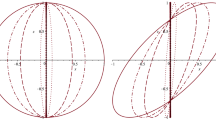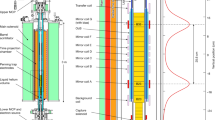Abstract
IN recent years there has been a good deal of controversy about gravitational radiation. Historically, the position is as follows. It was shown quite soon after the publication of the general theory of relativity that the linear approximation to the field equations  admits, in certain co-ordinate systems, solutions which have an obvious wave-like character; moreover, it appears from the energy pseudo-tensor that these waves carry energy away from the sources, as in the electromagnetic case. According to this linear theory, waves are emitted by systems of moving masses, and the rate of transmission of energy depends on the rate of change of the moments of inertia of the system1. Since the field equations (1) are nonlinear, these predictions of the linearized theory have to be treated with caution, and when, in 1938, a method of approximation which took account of the non-linearity was discovered by Einstein, Infeld and Hoffmann2, it seemed that the equations of motion of particles moving under their own gravitation contained no terms which corresponded to gravitational radiation. For various reasons this could not be taken as final evidence that gravitational radiation does not exist; but that work and some of its later developments3 cast serious doubts on the validity of the linearized theory.
admits, in certain co-ordinate systems, solutions which have an obvious wave-like character; moreover, it appears from the energy pseudo-tensor that these waves carry energy away from the sources, as in the electromagnetic case. According to this linear theory, waves are emitted by systems of moving masses, and the rate of transmission of energy depends on the rate of change of the moments of inertia of the system1. Since the field equations (1) are nonlinear, these predictions of the linearized theory have to be treated with caution, and when, in 1938, a method of approximation which took account of the non-linearity was discovered by Einstein, Infeld and Hoffmann2, it seemed that the equations of motion of particles moving under their own gravitation contained no terms which corresponded to gravitational radiation. For various reasons this could not be taken as final evidence that gravitational radiation does not exist; but that work and some of its later developments3 cast serious doubts on the validity of the linearized theory.
This is a preview of subscription content, access via your institution
Access options
Subscribe to this journal
Receive 51 print issues and online access
$199.00 per year
only $3.90 per issue
Buy this article
- Purchase on Springer Link
- Instant access to full article PDF
Prices may be subject to local taxes which are calculated during checkout
Similar content being viewed by others
References
Einstein, A., and Rosen, N., J. Franklin Inst., 223, 43 (1937).
Einstein, A., Infeld, L., and Hoffmann, B., Annals of Math., 39, 65 (1938).
Infeld, L., and Seheidegger, A. E., Canad. J. Math., 3, 195 (1951).
Takeno, H., Tensor (N.S.), 6, 15 (1956). Bondi, H., Nature, 179, 1072 (1957). Bonnor, W. B., J. Math. and Mech., 6, 203 (1957). Weber, J., and Wheeler, J. A., Rev. Mod. Phys., 29, 509 (1957).
Landau, L., and Lifshitz, E., “The Classical Theory of Fields”, 331 (Addison-Wesley Press, Cambridge, Mass., 1951).
Author information
Authors and Affiliations
Rights and permissions
About this article
Cite this article
BONNOR, W. Gravitational Radiation. Nature 181, 1196–1197 (1958). https://doi.org/10.1038/1811196a0
Issue Date:
DOI: https://doi.org/10.1038/1811196a0
Comments
By submitting a comment you agree to abide by our Terms and Community Guidelines. If you find something abusive or that does not comply with our terms or guidelines please flag it as inappropriate.



